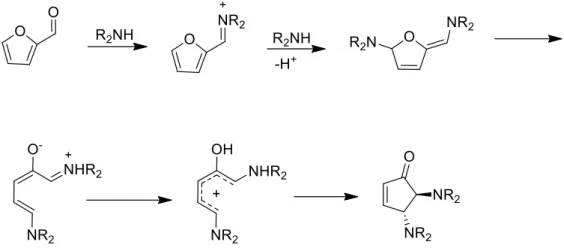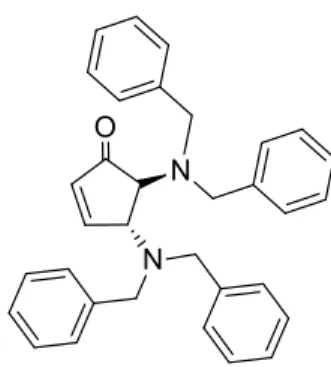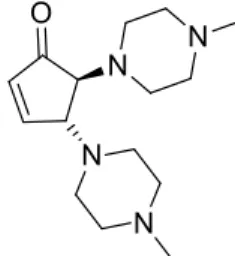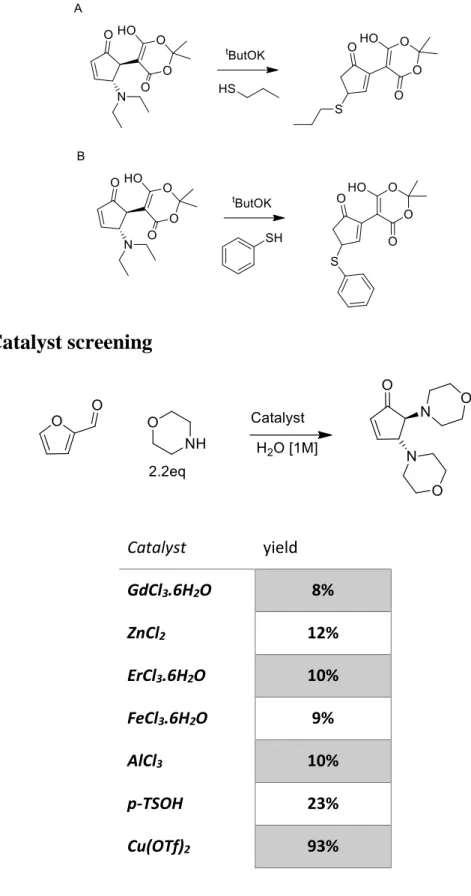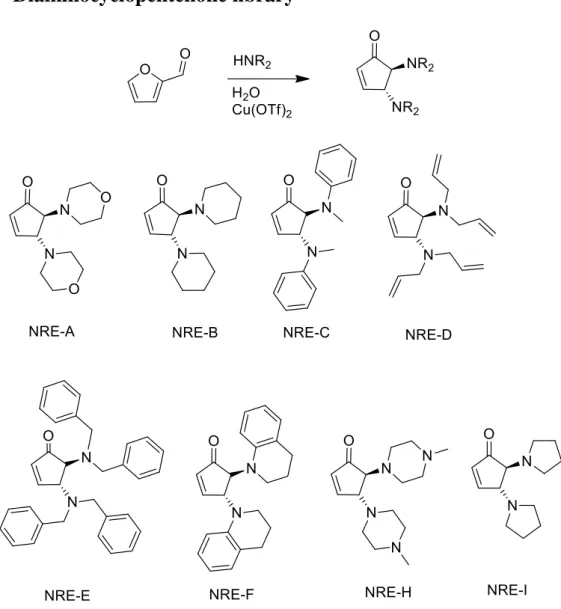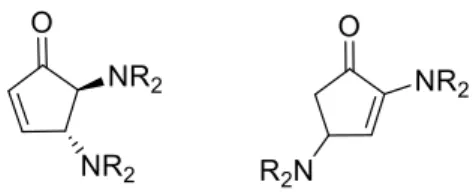Universidade de Lisboa
Faculdade de Farmácia
Synthesis and biological evaluation of
furfural carbocycles derivatives
Nuno de Carvalho Vidal Reis Esteves
Mestrado Integrado em Ciências Farmacêuticas
Universidade de Lisboa
Faculdade de Farmácia
Synthesis and biological evaluation of
furfural carbocycles derivatives
Nuno de Carvalho Vidal Reis Esteves
Monografia de Mestrado Integrado em Ciências Farmacêuticas apresentada à Universidade de Lisboa através da Faculdade de Farmácia
Orientador: Professor Doutor Carlos Afonso,
Professor Doutor Alexandre Trindade
Resumo
Furfural, um produto presente nos resíduos agrícolas do bagaço e do farelo, e o seu derivado ciclopentenonas, esta classe de moléculas remetem à década de 50 com um grande desenvolvimento na década de 70, no entanto continuam a abrir caminhos na química orgânica de síntese devido á sua presença em diversas moléculas naturais. Neste trabalho apresentamos uma maneira nova e dinâmica de sintetizar ciclopentenonas através do uso de Cu(OTf)2 em água e em menos de 5 minutos, abrindo
caminho para um grande leque de reatividade por ser explorada.
A outra parte do nosso trabalho é um estudo inicial sobre a síntese de ciclopentenonas disubstituidas, partindo de uma molécula ativada de furfural, cujo objetivo será estudar a sua interação com diversos nucleófilos e a sua possível integração em sistemas biológicos.
Abstract
Furfural, a natural product present in the agricultural wastes of bagasse and bran. Cyclopentenones have seen a great development since 1800’s to 1900’s and are still opening ways in organic synthesis as they are a type of building block present in various natural molecules.
In this work we present a new methodology of synthesising trans-4,5diamino-cyclopent-2-enones, with the use of Cu(OTf)2 in water in 5 minutes, paving the way for
a wide range of reactivity to be explored.
In continuity with this work we also propose an initial study of disubstituted cyclopentenones derived from an activated furfural with the purpose of studying their interaction with diverse nucleophiles and their possible integration in biological systems.
Acknowledgments
I would like to express my special thanks of gratitude to Professor Carlos Afonso and Professor Alexandre Trindade who gave me the golden opportunity to broaden my horizons and allowed me to be part of a greater project.
I would like to offer my special thanks to João Ravasco and Rafael Gomes for their never-ending support and patience along my stay in the laboratory.
My grateful thanks are also extended to everybody in Carlos Afonso group and Pedro Gois lab for their constant advice in numerous occasions.
Special thanks should be given to the group that accompanied me through the best years of faculty and made me the person I am today.
Finally, I wish to thank my parents for their support and encouragement throughout my study even in the most dire circumstances.
Index:
1 Introduction ... 7
1.1 History and uses of furfural and its derivatives cyclopentenones ... 7
1.2 Trans-4,5-diaminocyclopent-2-enones ... 8
1.3 Stenhouse salts and the formation of disubstituted cyclopentenones ... 10
2 Objectives ... 12
3 Materials and Methods ... 13
4 Synthesis of trans 4,5-disubstitutedcyclopent-2-enones ... 14
4.1 Synthesis of 2,2-dimethyl-1,3-dioxane-4,6-dione (NRE1) ... 14
4.2 Synthesis of 5-(furan-2-ylmethylene)-2,2-dimethyl-1,3-dioxane-4,6-dione (NRE2) ... 14 4.3 Synthesis of 5-((2Z,4E)-5-(diethylamino)-2-hydroxypenta-2,4-dien-1-ylidene)-2,2-dimethyl-1,3-dioxane-4,6-dione (NRE3) ... 15 4.4 Synthesis of 5-((1S,2R)-2-(diethylamino)-5-oxocyclopent-3-en-1-yl)-6-hydroxy-2,2-dimethyl-4H-1,3-dioxin-4-one NRE4 ... 15 5 Catalyst screening ... 16 6 Trans-4,5-diaminocyclopent-2-enones synthesis ... 17
6.1 Synthesis of trans-4,5-dimorpholinocyclopent-2-enone (NRE-A) ... 17
6.2 Synthesis of trans -4,5-di(piperidin-1-yl)cyclopent-2-enone (NRE-B) ... 18
6.3 Synthesis of trans-4,5-bis(methyl(phenyl)amino)cyclopent-2-enone (NRE-C) 18 6.4 Synthesis of trans-4,5-bis(diallylamino)cyclopent-2-enone (NRE-D) ... 19
6.5 Synthesis of trans-4,5-bis(dibenzylamino)cyclopent-2-enone (NRE-E) ... 20
6.6 Synthesis of trans-4,5-bis(3,4-dihydroquinolin-1(2H)-yl) cyclopent-2-enone (NRE-F) ... 21
6.7 Synthesis of trans-4,5-bis(4-methylpiperazin-1-yl)cyclopent-2-enone (NRE-H) 22 6.8 Synthesis of trans-4,5-di(pyrrolidin-1-yl)cyclopent-2-enone (NRE-I) ... 22
7 Discussion ... 24
7.1 Synthesis of 2,2-dimethyl-1,3-dioxane-4,6-dione (NRE1) ... 24
7.1 Synthesis of 5-(furan-2-ylmethylene)-2,2-dimethyl-1,3-dioxane-4,6-dione (NRE2) ... 24
7.2 Synthesis of ((2Z,4E)-5-(diethylamino)-2-hydroxypenta-2,4-dien-1-ylidene)-2,2-dimethyl-1,3-dioxane-4,6-dione (NRE3) and photocyclization) ... 25
7.3 Catalyst screening ... 26 7.4 Diaminocyclopentenone library ... 28 8 Conclusion ... 30 Bibliography ... 31 9 Annex ... 34 9.1 NRE2 ... 34 9.2 NRE-A ... 34 9.3 NRE-B ... 35 9.4 NRE-C ... 38 9.5 NRE-D ... 39 9.6 NRE-E ... 40 9.7 NRE-F ... 41 9.8 NRE-H ... 42 9.9 NRE-I ... 45
Image index
Figure 1: Cyclopentenones as a central motif in the synthesis of various prostaglandins
... 7
Figure 2: Nazarov rearrangement, a electrocyclic ring closure movement ... 9
Figure 3: The fist stenhouse salt ... 10
Figure 4: The innovative approach for the formation of asymmetrical cyclopentenones ... 11 Figure 5: 2,2-dimethyl-1,3-dioxane-4,6-dione ... 14 Figure 6: 5-(furan-2-ylmethylene)-2,2-dimethyl-1,3-dioxane-4,6-dione ... 14 Figure 7: 5-((2Z,4E)-5-(diethylamino)-2-hydroxypenta-2,4-dien-1-ylidene)-2,2-dimethyl-1,3-dioxane-4,6-dione ... 15 Figure 8: 5-((1S,2R)-2-(diethylamino)-5-oxocyclopent-3-en-1-yl)-6-hydroxy-2,2-dimethyl-4H-1,3-dioxin-4-one ... 15 Figure 16: (4S,5S)-4,5-dimorpholinocyclopent-2-enone ... 17 Figure 17: (4S,5S)-4,5-di(piperidin-1-yl)cyclopent-2-enone ... 18 Figure 18: (4R,5R)-4,5-bis(methyl(phenyl)amino)cyclopent-2-enone ... 18 Figure 19: (4S,5S)-4,5-bis(diallylamino)cyclopent-2-enone ... 19 Figure 20: (4R,5R)-4,5-bis(dibenzylamino)cyclopent-2-enone ... 20
Figure 21: (4R,5R)-4,5-bis(3,4-dihydroquinolin-1(2H)-yl) cyclopent-2-enone ... 21
Figure 22: (4S,5S)-4,5-bis(4-methylpiperazin-1-yl)cyclopent-2-enone ... 22
Figure 23: (4S,5S)-4,5-di(pyrrolidin-1-yl)cyclopent-2-enone ... 22
Figure 24: 4,5-diaminocyclopent-2-enone the main product and 2,4-diaminocyclopent-2-enone the undesirable side product ... 29
1 Introduction
1.1 History and uses of furfural and its derivatives cyclopentenones
Nowadays due to the increased consumption of fossil fuels and natural resources one of the main focus of the scientific community is the development of sustainable and renewable technologies to fight against the changes of the oil prices and the increased cost of raw materials.
One of the finest example of renewability is the use of products from biomass, being economic, easily accessible and CO2 neutral.1
Furfural is a light coloured liquid that quickly gains a dark complexion when exposed to the air, is found in agricultural waste products like bran and bagasse and it’s derived from the acid catalysed dehydration of 5 carbon sugars like xyloses, pentoses and hemicellulose. Being also responsible for the browning of the Maillard reactions in fried.2
This molecule has proved to have a great potential in the diversity of possible derivatives due to a carbonyl group and promising aspects in ring opening reactions due to its furan ring.
Cyclopentenones are a central motive in various natural products, with numerous applications as intermediates towards antitumor natural products such as agelastatin A3, (2)-cephalotaxine ester derivatives4, (+)-nakadomarin5, roseophilin6 and palau’amine7 , intermediates for (2)-cephalotaxine8, terpestacin9, nakadomarin A10, connatusin A11,
dactylospongenone A12 and aphagranins A and B13 and prostaglandin derivatives like
latanoprost, travoprost, etc.14
Figure 2: Examples of a cyclopentenone motif in natural molecules
Other uses have also been reported like the synthesis of potentials fungicides from metal chelates of 1, 7-Di (2-hydroxyphenyl)15 1, 7 di (N-methyl) aza-1, 3, 5
heptarine-3-ol hydrochloride, a highly selective and sensitive to Cu2+ chemodosimeter16 and
luminescent bicyclic boronates.17
1.2 Trans-4,5-diaminocyclopent-2-enones
Cyclopentenone reports were made using furfuryl alcohol and anilines, however the reactions were subjected to harsh conditions, with the use of hydrochloric acid and methanol in reflux, giving also low yields.18
To obviate these harsh conditions and to increase the yield the kind of molecules researchers turned around to the use of catalysts, thus decreasing the necessary energy needed for the reaction, through the use of Lewis acids. 19
The next breakthrough to this reaction was the use of scandium and dysprosium triflate, that diminished the reaction time for 16 hours at room temperature achieving quantitative yields with secondary amines. The reaction with primary amines was only possible with scandium triflate but in very low yields, dysprosium triflate was then chosen as the preferred catalyst due to its lower cost.
It was then inferred that the formation of the dihydrofurane intermediate was the rate dependent step, so it was deduced that the purpose of the catalyst was the formation of this intermediate and not the ring closing reaction, resulting in a Nazarov like rearrangement, a 4π conrotatory concerted mechanism.20
Following this first article new methodologies were developed, for example through the use of ionic fluid [HMim][BF4], that by being a Brøwnsted acid catalyses the reaction and reduces the time need to 5 min achieving 98% of yield and having the upside of the solvent being the catalyst.21
The next step was in the field of green chemistry using erbium as a catalyst in ethyl lactate, with the up side of having less toxicity than table salt. Both erbium (III) chloride and erbium triflate were studied and achieved quantitative yields in 30 min of reaction time. Erbium (III) chloride was then chosen as the optimal catalyst due to its very low cost comparing to Erbium triflate.22
Following this work, our group studied its application in a heterogenous system with its immobilization in silica and the catalyst reuse up to 8 cycles and recovered by filtration, optimized with n-butanol to provide the best yields. The isolated yields varied according with the amines used, ranging from moderate yields (39%) to high yields (95%)23
Other alternatives were made through the use of clusters catalysts like 3d/Dy and Ni”La”2 that not only increased the coordination sites and enabled the use of primary amines and secondary. Compared to the Batey catalyst, these clusters increased the air stability of dysprosium and a lesser loading requirement of 1% instead of 10%, making for a very useful catalyst for industrial aplications.24,25
Figure 3: The mechanism for the formation of cyclopentenones from furfural, via Nazarov type electrocyclization, a electrocyclic ring closure movement
The latest mentions in literature in terms of synthesis is the use of microwaves in water demonstrating a quick, 5min of reaction time, catalyst free alternative, achieving quantitative yields.26
1.3 Stenhouse
salts
and
the
formation
of
disubstituted
cyclopentenones
Cyclopentenones have a common precursor, Stenhouse salt, they were first discovered in by Stenhouse with the mixing of 1 equivalent of furfural, 2 equivalent of aniline and 1 equivalent of hydrochloric acid, giving a strongly coloured salt, a resonance stabilized penthaminium system.27
Afterwards the next step was a preparation of different Stenhouse salts, they purposed that the ring opening of furfural was due to the formation of the imine that destabilized the electronic system, promoting the attack with a suitable nucleophile in the position 5 of the furan, making a fast characterization of a wide range of compounds.28
The success in developing an imino-Nazarov cyclization derives from balancing the high stability of the pentadienyl cation, relative to the corresponding cyclic allylcation, due to its stabilization by a nitrogen atom.29
Furthering the subject of disubstituted cyclopentenones other alternatives were made with the use of different nucleophiles and arrived at a two-step one-pot method for the synthesis of 2-morpholino-4-thiofunctionalised cyclopentenones from furfural by sequential condensation with morpholine followed by treatment with thiol and catalytic base. With methanol as the preferred solvent and AlCl3 as the preferred Lewis
acid and tBuOK for the preferred base. 30
Further cyclopentenones were studied with the use of an activated furan, with for example a Meldrum’s acid and secondary amines, arriving to the conclusion that it depended on the type and amounts of amines used that influenced the pendadienyl cation. 31
Other more recent uses with disubstituted cyclopentenones is the creation of a turnable organic photoswitch based in furfural, these types of molecules have the ability to isomerise creating a molecule with different physical properties with the help of visible radiation. They were designed with various criteria in mind, activation with visible light, changes in the solubility and spectral absorption and easy synthetic methodology with a great malleability in terms of building blocks.
It was suggested that the ability to control the ring opening/closing mechanism of the cyclopentenone is entirely dependent of the push-pull system generated form the amine ring opening of furfural, the enolic OH group was determined to be a critical part of the molecule for the cyclization’s and the subsequent loss of colour.
New insights were given for the interconversion between the two states as being highly influenced by the solvent used, in protic solvents the triene with the help of visible light is converted to the colourless zwitterionic cyclopentenone form, whereas in halogenated solvents the photoisomerization would not occur.32
Figure 6: Furfural based organic photoswitch synthesis
2 Objectives
Our laboratory had and ongoing project, helmed by doctoral Student Rafael Gomes, which was the synthesis of trans 4,5- diamino-cyclopent-2-enones from furfural using Cu(OTf)2 as a catalyst in water. The optimal conditions, the competition essays, the
catalyst reuse cycles were already defined. As such I was integrated in the completion of the catalyst screening and the completion of the cyclopentenone library.
Also in the field of cyclopentenones our objective was to synthesise different cyclopentenones with the use of an activated furfural and an amine and study the posterior nucleophilic attack and release of the amine. Having in mind further applications with biological molecules and fluorescent probes.
3 Materials and Methods
NMR spectra were recorded on a Bruker Fourier 300 NMR spectrometer (1H 300 MHz; 13C 100, 61 MHz). 1H and 13C chemical shifts (δ) are expressed in ppm (parts per million) and are relative to the corresponding resonance of non-deuterated solvent. Sartorius analytic scale was used to weight the materials and Buchii RE11Rotavapor with thermostatic Buchii water bath was used for vacuum evaporation. The HPLC runs were made in an EC 250-4 NUCLEODUR® 100-5 C18 column, LC-20AT pump and the data collected by a CBM-102 Shimadzu model.
Solvents for flash chromatography and recrystallizations (hexane, EtOAc, MTBE, CH2Cl2) were of technical grade and distilled prior to use. THF was purified by
distillation from sodium/benzophenone prior to use. CH2Cl2 was purified by distillation
from CaH2, deuterated solvents for NMR were purchased from Cambridge isotope
laboratories. Reactions and fractions from flash chromatography were monitored by thin layer chromatography using precoated glass plates (Merck, silica 60 F254) and visualized by staining with basic KMnO4 solution or ninhydrine solution.
4 Synthesis of trans
4,5-disubstitutedcyclopent-2-enones
4.1 Synthesis of 2,2-dimethyl-1,3-dioxane-4,6-dione (NRE1)
Figure 7: 2,2-dimethyl-1,3-dioxane-4,6-dione
In a 50ml round bottom flask malonic acid (7g, 67.27mmol) was first dissolved in acetic anhydride (24ml, 253.9mmol, 3.8eq) with circa of 30 drops of H2SO4, and then acetone
was added (13ml, 172.18mmol, 2.5eq), for 2 hours under stirring. After the end of the reaction we quenched till pH5 with NaHCO3 and extracted with EtOAc, dried with
Na2SO4 and evaporated in low pressure obtaining a yield of 67% (6.5g).
4.2 Synthesis of
5-(furan-2-ylmethylene)-2,2-dimethyl-1,3-dioxane-4,6-dione (NRE2)
Figure 8: 5-(furan-2-ylmethylene)-2,2-dimethyl-1,3-dioxane-4,6-dione
In a 100ml round bottom flask NRE1 (1g, 6.94mmol) was dissolved in water (69ml) and added furfural (0.665mg, 6.94mmol, 1eq). The reaction was heated at 75ºC for 2 hours, cooled to room temperature and then put on an ice bath, the precipitate was recovered by filtration obtaining a yield of 50% (755mg).
1H NMR: δ 1.50 (s,6H), 6.57 (dd, J = 3.5, 1.8 Hz,1H), 7.44 (dd, J = 3.5, 0.8 Hz, 1H),
4.3 Synthesis of
5-((2Z,4E)-5-(diethylamino)-2-hydroxypenta-2,4-dien-1-ylidene)-2,2-dimethyl-1,3-dioxane-4,6-dione (NRE3)
Figure 9: 5-((2Z,4E)-5-(diethylamino)-2-hydroxypenta-2,4-dien-1-ylidene)-2,2-dimethyl-1,3-dioxane-4,6-dione
In a 5ml round bottom flask NRE2 (50mg, 0.225mmol) was dissolved in THF (0.56ml) and added diethyl amine (23ul, 0.225mmol, 1eq) and reacted for 10 min, it was then cooled with an ice bath and precipitate filtered and washed with diethyl ether obtaining a yield of 50% (50mg).
4.4 Synthesis of
5-((1S,2R)-2-(diethylamino)-5-oxocyclopent-3-en-1-yl)-6-hydroxy-2,2-dimethyl-4H-1,3-dioxin-4-one NRE4
Figure 10: 5-(trans-2-(diethylamino)-5-oxocyclopent-3-en-1-yl)-6-hydroxy-2,2-dimethyl-4H-1,3-dioxin-4-one
In a 5ml round bottom flask NRE3 (131mg, 443.57mmol, 1eq) was dissolved in the least amount of methanol possible, (1.1ml) it was then left for 24h under visible light. Afterwards the compound was filtered and washed with diethyl ether obtaining a yield of 85% (112mg).
5 Catalyst screening
General procedure for the catalyst screening
In a test tube 0.1eq of the catalyst was dissolved in H2O (0.1ml), morpholine was added
(19.95mg, 228.97mmol, 2.2eq) and furfural (10mg, 104.08mmol 1eq), stirring for 5 min. The reaction was then diluted with 5ml of H2O and extracted with EtOAc (3X2ml)
6 Trans-4,5-diaminocyclopent-2-enones
synthesis
6.1 Synthesis of trans-4,5-dimorpholinocyclopent-2-enone (NRE-A)
Figure 11: trans-4,5-dimorpholinocyclopent-2-enone
In a test tube Cu(OTf)2 (4mg, 10.41mmol, 0.1eq) was dissolved in H2O(0.1ml), then
morpholine was added (19.95µl, 228.97mmol, 2.2eq) and furfural (10mg, 104.08mmol 1eq), After stirring for 5 min, the reaction was diluted with 5ml of H2Oextraction with
EtOAc (3X2ml) and evaporated in low pressure, obtaining a yield of 93%(24.5mg).
1H NMR (300 MHz, CDCl 3) δ 7.60 (dd, J = 6.2, 2.2 Hz, 1H) 6.23 (dd, J = 6.2, 1.8 Hz, 1H) 3.81 (m, 1H) 3.72 (t, J = 4.6 Hz, 4H) 3.68 (t, J = 4.6 Hz, 4H) 3.28 (d, J = 3.0 Hz, 1H) 2.78-2.85 (dt, J = 11.5, 4.6 Hz, 2H ) 2.55-2.69 (m, 6H) 13C NMR (100 MHz, CDCl 3) δ 49.9, 50.2, 66.7, 67.2, 67.4, 68.2, 135.6, 160.7, 206.2.
6.2 Synthesis of trans -4,5-di(piperidin-1-yl)cyclopent-2-enone
(NRE-B)
Figure 12: trans-4,5-di(piperidin-1-yl)cyclopent-2-enone
In a test tube Cu(OTf) 2 (4mg, 10.41mmol, 0.1eq) was dissolved in H2O(0.1ml), then
pyrrolidine was added (19.95µl, 228.97mmol, 2.2eq) and furfural (10mg, 104.08mmol 1eq). After stirring for 5 min, the reaction was diluted with 5ml of H2Oextraction with
EtOAc (3X2ml) and evaporated in low pressure, obtaining a yield of 84% (21mg).
1H NMR (300 MHz, CDCl 3) δ 7.54 (d, J = 6.1 Hz, 1H) 6.11 (d, J = 6.1 Hz, 1H) 3.74 (m, 1H) 3.22 (m, 1H) 2.65-2.72 (m, 2H) 2.42-2.56 (m, 6H) 1.47-1.57 (m, 8H) 1.37-1.45 (m, 4H) 13C NMR (100 MHz, CDCl 3) δ 24.3, 24.5, 26.3, 26.6, 50.7, 51.1, 67.6, 68.4, 134.9, 162.1, 208.0.
6.3 Synthesis
of
trans-4,5-bis(methyl(phenyl)amino)cyclopent-2-enone (NRE-C)
Figure 13: trans-4,5-bis(methyl(phenyl)amino)cyclopent-2-enoneIn a test tube Cu(OTf) 2 (4mg, 10.41mmol, 0.1eq) was dissolved in H2O(0.1ml), then
extraction with EtOAc (3X2ml) and evaporated in low pressure, obtaining a yield of 82% (25mg). 1H NMR (300 MHz, CDCl 3) δ 7.64 (dd, J = 6.3, 2.1 Hz, 1H) 7.15 (m, 4H) 6.73 (m, 4H) 6.56 (d, J = 8.9 Hz, 2H) 6.48 (dd, J = 6.3, 2.1 Hz, 2H) 5.18 (m, 1H) 4.32 (d, J = 3.6 Hz, 1H) 2.85 (s, 3H) 2.82 (s, 3H). 13C NMR (100 MHz, CDCl 3) δ 33.9, 36.9, 62.8, 70.0, 113.9, 114.4, 118.3, 118.8, 129.3, 129.4, 134.7, 148.8, 149.2, 161.6, 202.3
6.4 Synthesis of trans-4,5-bis(diallylamino)cyclopent-2-enone
(NRE-D)
Figure 14: trans-4,5-bis(diallylamino)cyclopent-2-enone
In a test tube Cu(OTf) 2 (4mg, 10.41mmol, 0.1eq) was dissolved in H2O(0.1ml), then
diallylamine was added (29.27µl, 228.97mmol, 2.2eq) and furfural (10mg, 104.08mmol 1eq). After stirring for 5 min, the reaction was diluted with 5ml of H2Oextraction with
EtOAc (3X2ml) and evaporated in low pressure, obtaining a yield of 66% (13.25mg).
1H NMR (300 MHz, CDCl 3) δ 7.47 (dd, J = 6.2, 2.1 Hz, 1H) 6.17 (dd, J = 6.2, 1.9 Hz, 1H) 5.77-5.90 (m, 4H) 5.10-5.26 (m, 8H) 4.10 (m, 1H) 3.59 (d, J = 3.3 Hz, 1H) 3.08-3.42 (m, 8H). 13C NMR (100 MHz, CDCl 3) δ 53.8, 54.7, 63.7, 65.2, 117.8, 117.8, 135.1, 136.4, 136.8, 162.8, 208.2.
6.5 Synthesis
of
trans-4,5-bis(dibenzylamino)cyclopent-2-enone
(NRE-E)
Figure 15: trans-4,5-bis(dibenzylamino)cyclopent-2-enone
In a test tube Cu(OTf)2 (4mg, 10.41mmol, 0.1eq) was dissolved in H2O(0.1ml), then
dibenzylamine was added (44.02µl, 228.97mmol, 2.2eq) and furfural (10mg, 104.08mmol 1eq). After stirring for 5 min, the reaction was diluted with 5ml of H2O
extraction with EtOAc (3X2ml) and evaporated in low pressure, obtaining a yield of 71% (21mg). 1H NMR (300 MHz, CDCl 3) δ 7.59 (dd, J = 6.2, 2.2 Hz, 1H) 7.20-7.32 (m, 20H) 6.20 (dd, J = 6.2, 1.9 Hz, 1H) 4.05 (q, J = 2.3 Hz, 1H) 3.83 (d, J = 13.2 Hz, 2H) 3.61 (d, J = 2.9 Hz, 1H) 3.54 (d, J = 13.2 Hz, 2H) 3.39 (s, 4H) 13C NMR (100 MHz, CDCl 3) δ 54.7, 55.1, 63.4, 64.5, 127.2, 127.3, 128.3, 128.4, 128.8, 129.7, 135.6, 139.4, 139.4, 163.2, 208.7.
6.6 Synthesis
of
trans-4,5-bis(3,4-dihydroquinolin-1(2H)-yl)
cyclopent-2-enone (NRE-F)
Figure 16: trans-4,5-bis(3,4-dihydroquinolin-1(2H)-yl) cyclopent-2-enone
In a test tube Cu(OTf)2 (4mg, 10.41mmol, 0.1eq) was dissolved in H2O(0.1ml), then
1,2,3,4-tetrahydroquinoline was added (28.74µl, 228.97mmol, 2.2eq) and furfural (10mg, 104.08mmol 1eq). After stirring for 5 min, the reaction was diluted with 5ml of H2Oextraction with EtOAc (3X2ml) and evaporated in low pressure, obtaining a yield
of 81% (30mg). 1H NMR (300 MHz, CDCl 3) δ 7.67 (dd, J = 6.2, 2.0 Hz, 1H) 7.0 (d, J = 7.4 Hz, 2H) 6.87-6.94 (m, 2H) 6.63 (tdd, J = 7.3, 2.5, 1.1 Hz, 2H) 6.53 (m, 2H) 6.11 (d, J = 8.2 Hz, 1H) 5.40 (s, 1H) 4.33 (s, 1H) 3.15-3.36 (m, 4H) 2.71-2.72 (m, 4H) 1.90-2.02 (m, 4H) 13C NMR (100 MHz, CDCl 3) δ 22.4, 22.6, 28.0, 28.1, 45.4, 59.9, 68.5, 110.9, 111.6, 117.2, 117.4, 123.6, 123.7, 126.9, 127.2, 129.6, 129.6, 134.4, 143.6, 144.4, 161.8, 202.1
6.7 Synthesis of
trans-4,5-bis(4-methylpiperazin-1-yl)cyclopent-2-enone (NRE-H)
Figure 17: trans-4,5-bis(4-methylpiperazin-1-yl)cyclopent-2-enone
In a test tube Cu(OTf)2 (4mg, 10.41mmol, 0.1eq) was dissolved in H2O(0.1ml), then
methylpiperazine was added (25,40µl, 228.97mmol, 2.2eq) and furfural (10mg, 104.08mmol 1eq). After stirring for 5 min, the reaction was diluted with 5ml of H2O
extraction with EtOAc (3X2ml) and evaporated in low pressure, obtaining a yield of 76% (22mg). 1H NMR (300 MHz, CDCl 3) δ 7.60 (dd, J = 6.2, 2.2 Hz, 1H) 6.22 (dd, J = 6.2, 1.8 Hz, 1H) 3.89 (q, J = 2.1 Hz, 1H) 3.35 (d, J = 3.0 Hz, 1H) 2.76-2.79 (m, 2H) 2.61-2.69 (m, 6H) 2.47 (broad s, 8H) 2.29 (s, 6H). 13C NMR (100 MHz, CDCl 3) δ 46.1, 49.2, 49.4, 55.4, 65.7, 67.9, 135.3, 161.4, 206.0.
6.8 Synthesis
of
trans-4,5-di(pyrrolidin-1-yl)cyclopent-2-enone
(NRE-I)
Figure 18: trans-4,5-di(pyrrolidin-1-yl)cyclopent-2-enoneIn a test tube Cu(OTf)2 (4mg, 10.41mmol, 0.1eq) was dissolved in H2O(0.1ml), then
pyrrolidine was added (18.80µl, 228.97mmol, 2.2eq) and furfural (10mg, 104.08mmol 1eq). After stirring for 1 min, the reaction was diluted with 5ml of H2Oextraction with
1H NMR (300 MHz, CDCl 3) δ 7.56 (dd, J = 6.2, 2.2 Hz, 1H) 6.16 (dd, J = 6.1, 1.6 Hz, 1H) 3.71 (m, 1H) 3.28 (d, J = 2.7 Hz, 1H) 2.85-2.88 (m, 2H) 2.61-2.68 (m, 6H) 1.67-1.76 (m, 8H). 13C NMR (100 MHz, CDCl 3) δ 23.6, 23.9, 50.2, 50.8, 66.0, 67.3, 134.8, 161.2, 208.2.
7 Discussion
7.1 Synthesis of 2,2-dimethyl-1,3-dioxane-4,6-dione (NRE1)
Regarding the first phase of our work the first reaction (NRE1), the yield was expected to be greater than of 67%, as in the literature it has been described for having yields ranging from 75% to 90%33, the most probable cause should be the quenching phase with NaHCO3. The quenching is required for the desired product revert to its neutral
state to leave the aqueous phase, we might have not achieved the desired pH of 4 to 5 required for the work-up, impacting the final yield.
7.1 Synthesis of
5-(furan-2-ylmethylene)-2,2-dimethyl-1,3-dioxane-4,6-dione (NRE2)
The most problematic step was the conjugation of NRE1 with furfural, as one of the main problems with furfural reactions is the formation of a dark brown uncharacterized polymer when we work at temperatures above 40ºC34, however the condensation with the Meldrum’s acid only occurs at 75ºC. So, in order to control the degradation that would occur during the reaction we payed special attention to the colour changes and stopped the reaction when there was a significant change of colour to brown.
The expected product should have been, according to the literature, a white solid, but what resulted from our reactions was a heterogenous thin solid with a darker appearance. This reaction was also done by an undergrad student giving a deep black solid, although both our desired molecules were present according to nmr
characterisation, when used in following reactions our starting material gave significantly greater yields, 50% versus a negligible yield.
7.2 Synthesis of
((2Z,4E)-5-(diethylamino)-2-hydroxypenta-2,4-dien-1-ylidene)-2,2-dimethyl-1,3-dioxane-4,6-dione
(NRE3)
and
photocyclization)
The reaction with the diethylamine created a strongly red coloured compound almost instantly, that was filtered and washed. Although the use of MTBE instead of diethyl ether might have contributed to a small decrease in yield, from 85% to 50%.
The cyclization step also occurred but on the contrary to the literature the compound retained its deep red colour instead of becoming a colourless liquid. Also, the nmr analysis was made in CDCl3 where it showed the cyclized form, against what was stated
in the literature.
The next step was then the nucleophilic attack with thiols that would simulate the glutathione attack to these molecules. We had planned to do this reactions with two thiols, propanethiol, being a linear alkylic thiol, simulating glutathione and thiophenol that by being bulkier might be sterically hindered to react and would be in theory less reactive, with use of an already studied and optimized base (tButOK) to promote the nucleophilic attack.30 Unfortunately, this part of our project had to be left behind due to time concerns for our second half of our objectives.
7.3 Catalyst screening
Table 1: comparison between the various catalysis used
Regarding the catalyst screening, it has been referred that rare earth lewis acid are the
Catalyst yield GdCl3.6H2O 8% ZnCl2 12% ErCl3.6H2O 10% FeCl3.6H2O 9% AlCl3 10% p-TSOH 23% Cu(OTf)2 93%
that have a greater tendency to form oxides by hydrolysis or abstraction of oxygen have been reported to have a better yield.
However, we can see that for reactions under 5 minutes except for the Cu(OTf)2 all had
a yield lesser than 50%
The most surprising case can be the AlCl3 that has been reported to catalyse similar
reactions but in this case, it presents a very low yield, it might be due to the fact that the reactions are made in aqueous media and HCl is formed degradating furfural and stopping the reaction.
The results given with the use of p-Toluenesulfonic acid (p-TSOH) might infer that in catalytic amounts, the presence of a Brønsted acid can have a degree in the formation of cyclopentenones, but not enough to be considered a true effective catalyst.
7.4 Diaminocyclopentenone library
Figure 19: Diaminocyclopentenone library
All these reactions were synthesised in the same way; however, we can say that there is a huge difference between the reaction times and the formation of degradation product. It is known that 2,4-diaminocyclopent-2-enones are more stable than the desired compound 4,5-diaminocyclopent-2-enone, and we found that through different reactions times of 5 minutes, 30 minutes and one hour that the signal for this undesirable compound, 2,4-diaminocyclopent-2-enone, increased, and we ended with a mixture of both products that were impossible to separate in terms of column chromatography. The cyclopentenones made with morpholine, and 1,2,3,4-tetrahydroquinoline were the most stable in the cases of prolonging the reaction up to 15 min, however the other amines had a marked formation of side products along the reaction time. The pyrrolidine case was the most extreme case where in less than a minute we had the
cyclopentenone formed, and almost immediately we had the formation of the undesirable side product, contributing to a challenging time in isolating the compound
Figure 20: 4,5-diaminocyclopent-2-enone the main product and 2,4-diaminocyclopent-2-enone the undesirable side product
These molecules are known for their instability, as such this problem also occurred when we evaporated at low pressure, the bath that is used could not be at 40ºC as it would decompose our molecules to the starting material. Regarding other amines that could be used for this reaction we tried with imidaloze, indol, prolinebenzylester and piperazine. In the case of the indole and the imidazole rings we didn’t saw any change in the TLC, this might have been due to the ring resonance that prevented the catalyst connection. The prolynebenzylester was only done once due to lack of starting material and regarding piperidine we observed that we had the product but it wasn’t pure, and with the increase of reaction time we increase the possibility of polymer formation.
8 Conclusion
In this work we can conclude in a new and quick way to produce diaminocyclopentenones, using Cu(OTf)2 selective for secondary amines.
Future prospects would be the application with biological molecules in biological media, this methodology offers a better alternative, comparing with the use of microwaves that was reported26 for the fact that the use of radiations in biological
molecules might decompose them rending them unable to react, whereas our methodologies might have a greater success in bioconjugations due to examples in literature, for example the use of copper to catalyse [3+2] cycloadditions with proteins35.
Regarding the disubstituted cyclopentenones the next step is to conduct the reactions with the nucleophilic attack and its application in biological media, like connection with a fluorescent probe and also naturally occurring nucleophiles like glutathione.
Bibliography
(1) Lange, J.-P.; van der Heide, E.; van Buijtenen, J.; Price, R. ChemSusChem 2012,
5 (1), 150.
(2) Hofmann, T. J. Agric. Food Chem. 1998, 46 (3), 932.
(3) Menjo, Y.; Hamajima, A.; Sasaki, N.; Hamada, Y. Org. Lett. 2011, 13 (21), 5744. (4) Takano, I.; Yasuda, I.; Nishijima, M.; Hitotsuyanagi, Y.; Takeya, K.; Itokawa,
H. J. Nat. Prod. 1996, 59 (12), 1192.
(5) Magnus, P.; Fielding, M. R.; Wells, C.; Lynch, V. Tetrahedron Lett. 2002, 43 (6), 947.
(6) Luker, T.; Koot, W.-J.; Hiemstra, H.; Speckamp, W. N. J. Org. Chem. 1998, 63 (2), 220.
(7) Namba, K.; Inai, M.; Sundermeier, U.; Greshock, T. J.; Williams, R. M.
Tetrahedron Lett. 2010, 51 (50), 6557.
(8) Berhal, F.; Pérard-Viret, J.; Royer, J. Tetrahedron: Asymmetry 2010, 21 (3), 325. (9) Berger, G. O.; Tius, M. A. Org. Lett. 2005, 7 (22), 5011.
(10) Leclerc, E.; Tius, M. A. Org. Lett. 2003, 5 (8), 1171.
(11) Rukachaisirikul, V.; Tansakul, C.; Saithong, S.; Pakawatchai, C.; Isaka, M.; Suvannakad, R. J. Nat. Prod. 2005, 68 (11), 1674.
(12) Kushlan, D. M.; Faulkner, D. J.; Parkanyi, L.; Clardy, J. Tetrahedron 1989, 45 (11), 3307.
(13) Wang, J.-S.; Zhang, Y.; Wang, X.-B.; Wei, D.-D.; Luo, J.; Luo, J.-G.; Yang, M.-H.; Yao, H.-Q.; Sun, H.-B.; Kong, L.-Y. Tetrahedron Lett. 2012, 53 (14), 1705. (14) Henschke, J. P.; Liu, Y.; Huang, X.; Chen, Y.; Meng, D.; Xia, L.; Wei, X.; Xie, A.; Li, D.; Huang, Q.; Sun, T.; Wang, J.; Gu, X.; Huang, X.; Wang, L.; Xiao, J.; Qiu, S. 2012, No. Figure 1.
(15) Hathi, M. V. 2010, 7 (3), 775.
(16) Wang, Q.; Zhang, H.; Jiang, Y. Tetrahedron Lett. 2009, 50 (1), 29.
55, 6088.
(18) Lewis, K. G.; Mulquiney, C. E. Rearrangements in the furan series. I. The
reaction between furfuraldehyde and aniline; 2017; Vol. 23.
(19) W, C. Tetrahedron Org. Chem. Ser. 1990, 8.
(20) Li, S.-W.; Batey, R. A. Chem. Commun. 2007, No. 36, 3759.
(21) Ramesh, D.; Reddy, T. S.; Narasimhulu, M.; Rajaram, S.; Suryakiran, N.; Mahesh, K. C.; Venkateswarlu, Y. Ã. Chem. Lett. 2009, 38 (6), 5.
(22) Procopio, A.; Costanzo, P.; Curini, M.; Nardi, M.; Oliverio, M.; Sindona, G. ACS
Sustain. Chem. Eng. 2013, 1 (5), 541.
(23) Estevão, M. S.; Afonso, C. A. M. Tetrahedron Lett. 2016, No. Iii, 2.
(24) Griffiths, K.; Kumar, P.; Mattock, J. D.; Abdul-Sada, A.; Pitak, M. B.; Coles, S. J.; Navarro, O.; Vargas, A.; Kostakis, G. E. Inorg. Chem. 2016, 55 (14), 6988. (25) Griffiths, K.; Gallop, C. W. D.; Abdul-Sada, A.; Vargas, A.; Navarro, O.;
Kostakis, G. E. Chem. - A Eur. J. 2015, 21 (17), 6358.
(26) Nardi, M.; Costanzo, P.; De Nino, A.; Di Gioia, M. L.; Olivito, F.; Sindona, G.; Procopio, A. Green Chem. 2017, 19 (22), 5403.
(27) Stenhouse, J. Justus Liebigs Ann. Chem. 1850, 74 (3), 278.
(28) Šafář, P.; Považanec, F.; Zaliberab, L.; Berkeš, D. Czech. Chem. Commun 1993,
58 (3), 555.
(29) William, R.; Wang, S.; Ding, F.; Arviana, E. N.; Liu, X. 2014, 10742. (30) Nunes JPM, Afonso CAM, C. S. RSC Adv. 2013, 2.
(31) Šafář, P.; Považanec, F.; Prónayová, N.; Baran, P.; Kickelbick, G.; Kožíšek, J.; Breza, M. Czech. Chem. Commun 2000, 65 (12), 1991.
(32) Helmy, S.; Oh, S.; Leibfarth, F. A.; Hawker, C. J.; Alaniz, J. R. De. 2014. (33) Relenyi, A. G.; Wallick, D. E.; Streit, J. D. Process for the preparation of
Meldrum’s acid. US 2440442 A, 1986.
(34) Hillyer, J. C.; Nicewander, D. A. Inhibiting polymerization of furfural. US 4613671 A, 1948.
(35) Wang, Q.; Chan, T. R.; Hilgraf, R.; Fokin, V. V; Sharpless, K. B.; Finn, M. G.
9 Annex
9.1 NRE2
COSY of NRE-H:
HMBC of NRE-H:
MS of NRE-H:
RG897_np #64 RT:0.28 AV:1 NL:3.93E4
T:ITMS + c ESI Full ms [100.00-2000.00]
220 230 240 250 260 270 280 290 300 310 320 330 340 m/z 0 10 20 30 40 50 60 70 80 90 100 R e la ti v e Ab u n d a n c e 279.19 280.17 319.19 274.46 281.17 301.13 329.19 237.17 222.19 233.29 246.30 257.03 267.00 294.97 304.80311.08 340.96 346.38

